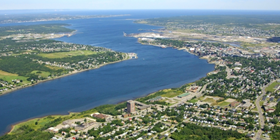Port of Sydney Development Corporation CEO Marlene Usher has donned a new cap – that of “maritime historian” – for the first of what she promises will be a series of Cape Breton Post columns sharing “her thoughts” on the Sydney port development project.
My first thought, on reading this, was, “How odd that as we prepare to celebrate 20 years of the Cape Breton Regional Municipality we're still talking about the Port of Sydney,” but I'll hold that thought for now.
Usher's thoughts, it must be noted, are very similar to those of Barry Sheehy, one half of Harbor Port Development Partners, the firm that is promoting our port out of, apparently, the goodness of its founders' hearts.
As for her grasp of Cape Breton history (the focus of her debut “Port of Call” column), it is not to be compared to that of say, the late Robert Morgan, but it is really, really funny. (And before I'm accused of posing as an historian myself, let me explain that I read one of Morgan's books on Cape Breton, plus the Parks Canada website for the Fortress Louisbourg and I completed grade seven history, all of which has – rather to my surprise – left me admirably equipped to critique Usher's column.)
According to her thesis, the history of the Port of Sydney begins in Louisbourg in “the 18th century.”
Historians have a term for claims like these, they call them “random” (and if they don't, they should).
Cape Breton's maritime history, like all other aspects of its history, begins with its first peoples, the Mi’kmaq, who, you may recall, actually have a claim to Sydney harbor and who expect to have “meaningful and significant involvement” in its development, according to Membertou Chief Terry Paul.
But if the absence of aboriginal peoples from Usher's account is odd, even odder, in a history of colonial Cape Breton, is the absence of the British. Consider this paragraph, packed like a shipping container with questionable historic assertions:
“When the French committed to establishing themselves on Isle Royale in the 18th century, the decision was both strategic and commercial. It was our strategic location near Europe and the Mediterranean that brought the Basques and later the French to Cape Breton. On a strategic level they recognized Isle Royale as the first stop on the latitude lines from Normandy. In short, we were closer.”
Now read the Parks Canada version of this historic period:
“The French came to Louisbourg in 1713, after ceding Acadia [which included mainland Nova Scotia] and Newfoundland to the British by the terms of the Treaty of Utrecht, which ended the War of the Spanish Succession. France's only remaining possessions in what is now Atlantic Canada were the islands of Cape Breton and Prince Edward, which were then called Isle Royale and Isle Saint-Jean. The French used these islands as a base to continue the lucrative cod fishery off the Grand Banks.”
Professor Usher gives a delightfully fresh reading of these facts but I must reluctantly bow to the Parks Canada version: the main attraction of Atlantic Canada was the cod and the main attraction of Louisbourg, for the French, was not its proximity to Normandy ("I can see Normandy from my front porch!" said no one in Louisbourg ever) but the fact that they owned it.
Usher continues:
“[The French] also recognized that the Island's location, sticking out into the eastern Atlantic, made trade with Europe and the West Indies much easier.”
Full points for the lyrical description of Cape Breton as an island “sticking out into the eastern Atlantic” but what does that sentence actually mean? That, during a period of almost-continual warfare with the British, the French found it “much easier” to trade from a port that was actually in their possession?
But Usher has another card up her sleeve—the role of Isle Royale in defending the mouth of the St. Lawrence:
“Finally, [the French] saw that a fortified and garrisoned Isle Royale could act as guardian of the St. Lawrence and the maritime route to Quebec, Montreal, the Great Lakes and the center of North America.
“Thus came to be the mighty fortress of Louisbourg.”
Here, I must admit, I spit coffee all over page A11 of the Saturday paper. Somebody is in for an awful shock when she gets to the end of whatever history of the Island she's reading. As the Parks Canada website explains:
“One might think that the fortress would be prepared for any onslaught. Yet, while the harbor was well defended, the main landward defences were commanded by a series of low hills, some dangerously close to the fortifications. All provided excellent locations for siege batteries.”
So excellent were these siege battery locations that the “mighty” fortress was taken by a group of New Englanders in 1745 (just after construction was completed), returned to the French three years later by the Treaty of Aix-a-Chapelle, then taken a second time by the British in 1758, after which (SPOILER ALERT) they blew it up.
But Usher won't be dragged down by such negativity. She looks at the history of the Port of Louisbourg and sees the future of the Port of Sydney. In fact (and rather confusingly) she sees the two ports as one and the past and the future as happening simultaneously:
“The winning formula was as clear then as it is today. A strategically located deep-water harbor, focused on trading with the world, linked with the St. Lawrence and continental North America, producing incredible prosperity both in the past and the future.”
And there you have it: the winning formula—having two Colonial powers fighting for domination around you for a couple of hundred years—has produced incredible prosperity in the future.
I won't deny it – I can't wait for the next installment of Port of Call.





27
Log In or Sign Up to add a comment.- 1
arrow-eseek-e1 - 4 of 4 itemsFacebook Comments